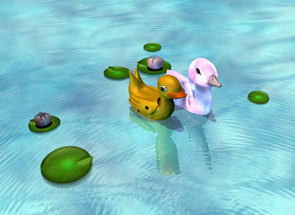| |
|
|
|
|
||
|
||||||||||||||||||||
| |
|
|
|
|
 |
|
 |
|||
| |
||||||||||
| |
||||||||||
 |
|
|||||||||
| |
||||||||||
| |
||||||||||
| |
||||||||||
| |
 |
|
Rubber Duck: Golden Nica – u19 freestyle computing
"Rubber Duck" by 18 years old Georg Sochurek tells a tale of woe about a little rubber duck's life in the guise of a modern fable. This highly proficient animation centers around topics like being different, malevolence, suffering and sudden changes of fate. Rubber Duck tells a strange tale of woe about a little rubber duck in the guise of a modern fable: it revolves around topics like being different, suffering, the wickedness of the world and of fate. Even if the term "drama" seems a bit exaggerated here, it is exactly what the film is supposed to be. It should make people think and feel compassion, as well as ask what parallels exist between the story and the real, "wicked" world. But first things first: Everything begins with a little rubber duck floating about all alone on the sea. Soon a few "real" ducklings appear who then take off to get their mother so they can show her their strange find. After briefly examining the lifeless body, the duck family decides to take in the rubber duck. Yet the little rubber duck cannot adapt to family life; it is expelled and once again floats about all alone on the sea. Suddenly a sea monster shows up out of nowhere and gobbles it up. When the rubber duck reappears, bobbing on the waves, it has bite marks. But its loneliness is not to last long: soon a delightful lady duck swims up – she rights the little duck and clasps it tightly to her. Yet this happiness is short-lived: they soon run into two thuggish ducks who are evidently out to get the rubber duck. And here lurks immediately another, sadistic misfortune: the lady duck does not come to the rubber duck’s aid, but turns out to be a friend of the two thugs – she has merely lured the little duck into a trap. In the end, she gives her friends a sign to do the little rubber duck in. No sooner said – than done. Afterwards, when the three are gone, (the rubber duck is now in a very sorry state) it encounters its final challenge: suddenly, out of the dark, two mighty stone ducks loom large, silent guardians of a strange waterfall. And how could it be otherwise – the little duck is whisked off by the current, but just before it plunges over the ledge, falling rocks save its life (its *life*?). But then, at the very moment when the waves from the rocks are washing the little duck to safety, it shows emotion for the first (and last) time: it remembers everything wicked which has happened to it, starts to cry and comes to a decision: it turns round and lets itself be swept towards the falls, plunging into the depths – or is this not what happens? During the entire film a certain mystical quality prevails: Is the rubber duck alive? Can it think? Or is it really just the lifeless piece of plastic it appears to be? (The end should encourage viewers to make their own interpretations). Where did the rubber duck come from, anyway? And what happens after it plunges over the falls? It is up to the viewer to detect, understand and interpret all of these unspoken questions. The most important detail for me is the (at least outwardly) complete apathy of the protagonist. No matter what happens, the little duck does not bat an eyelash – that is, presuming it might be able to do so. But does this mean that it is indifferent toward everything? The contrast between experiencing sorrow and affliction, and being “nevertheless above such things” or perhaps even “of another world“ constitutes for me the central theme of “Rubber Duck”. What the little rubber duck does not outwardly show, the viewer should experience and feel (with it). And I indeed hope this will be the case … Georg Sochurek |  |
|
|||||
| |
||||||||||
| |
||||||||||
| |
 |
|||||||||
| © Ars Electronica Linz GmbH, info@aec.at | ||||||||||